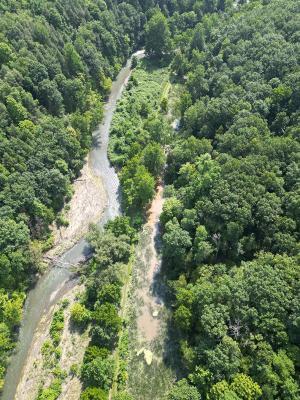GLRI funds are supporting an innovative approach to water quality improvement in the Finger Lakes region of New York State. Efforts are underway to reestablish surface water conductivity of the abandoned Crooked Lake Canal that runs parallel along the Keuka Outlet stream to create wetland habitats in sections of the unused, historic canal system. Keuka Outlet begins in Penn Yan as the outflow of Keuka Lake, extending about 8 miles and dropping 270 feet in elevation to ultimately empty into Seneca Lake at Dresden, NY. The Seneca Watershed Intermunicipal Organization (SWIO), Seneca Lake Pure Waters Association and Finger Lakes Institute of Hobart and William Smith College have long documented excessive nutrient pollution, streambank erosion and downstream flooding along the Keuka Outlet, impacting Seneca Lake downstream. Fortunately, remnants of the historic canal system provide a solution to these water quality issues.
Four locations along the Canal/Outlet channels have been identified as viable diversion locations for this project. Two diversion locations involve the installation of pre-cast concrete pond risers within tributaries flowing from the north into the Keuka Outlet. This management technology maintains normal flows under normal conditions. However, when flow rates increase, water begins to collect and eventually flows downhill into areas of the former canal when the flow of water increases. At two other diversion locations, water will be directed out of the Keuka Outlet via culverts. These culverts are set an elevation such that water only flows into them under stormflow conditions when water quality is at its worst.Model estimates suggest the combined systems can divert 34 million gallons of stormwater flows and sequester 45 pounds of phosphorus from a single 10-year storm event. Project partners are leveraging the ecosystem services of the former canal system/newly reconnected wetland areas to mitigate flooding, reduce streambank erosion and reduce excessive phosphorus transport in downstream Seneca Lake.
The project leverages the Keuka Outlet Trail and partnership with the Friends of the Outlet – an organization dedicated to preserving the history, environmental benefits and recreation access along the Outlet and to maximize public engagement. This past spring, SWIO and Keuka College Visual Communication Design students conceptualized and created interpretive signage for each of the four diversion locations highlighting the unique history and water quality solutions of the former Crooked Lake Canal. This project is an example of innovative repurposing of an abandoned canal system to yield much needed environmental benefits for the Great Lakes Basin.


